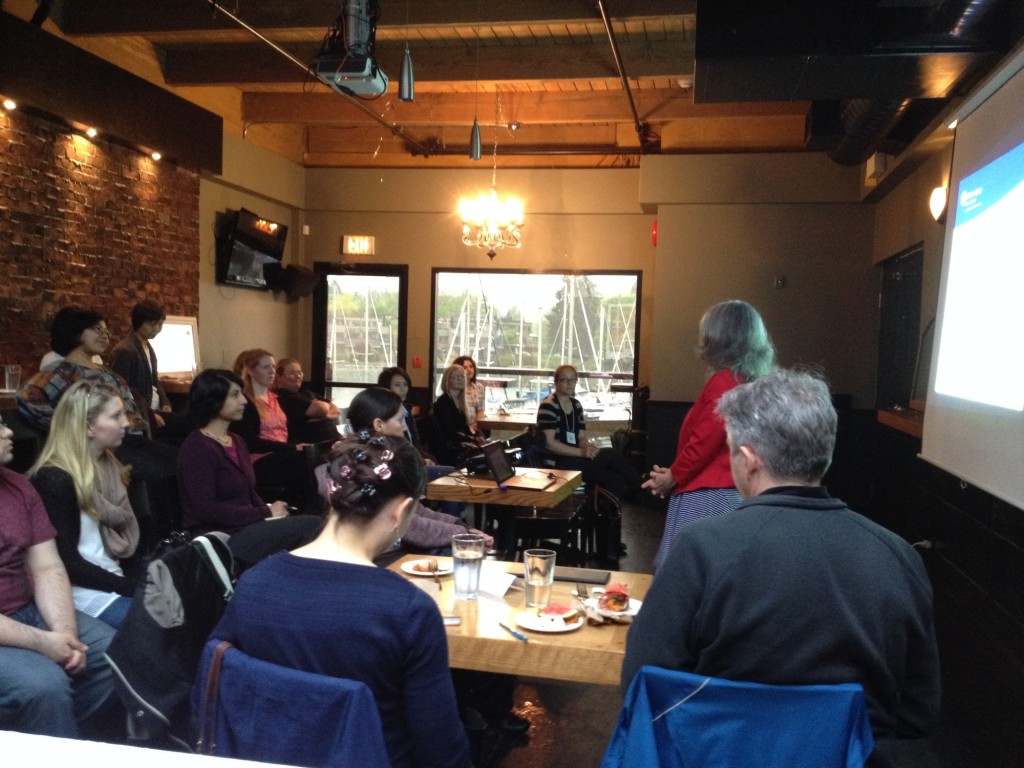“Breast and Ovarian Cancer-Not Only a Disease for Older Women” [Event Recap]
Back to Posts
On May 8 2014, we were fortunate enough to have Katarina Rothe as our moderator for this Café Scientifique. Katharina is a PhD candidate at the Terry Fox Laboratory at the BC Cancer Research Centre and is also part of the Department of Medical Genetics here at UBC. Her research focuses on understanding the metabolic properties of chronic myeloid leukemia, a white blood cell cancer, with the goal of improving treatment outcomes in patients. Besides her enthusiasm for cancer research, Katharina is involved in numerous departmental and teaching activities, she is also the President for the Graduate and Postdoctoral Fellow Society.
Dr. Marilyn Borugian, Ph.D. is a Clinical Associate Professor at UBC in the School of Population and Public Health department and was our first speaker for the night. As part of Dr. Borugian’s ongoing research, she examines dietary and metabolic factors and how these factors influence breast cancer. In her talk, she advised the audience to question what group scientific studies use. For example, was the study in question being conducted on children, adults or the elderly as this could influence the conclusions being made. In addition, she said to pay particular attention to the size of the risk of each study, paying particular attention whether eating a specific food, for example, could increase your risk of cancer development by 10% or 400%. Obviously 400% is more impactful and should warn the reader to be particular cautious with this food type. However, 10% is a far less risk and thus, this food type should not be completely avoided.
She then went on to describe particular risk factors such as: lifestyle, socio-economic status, light at night, and breast density. Her main conclusions were: your diet is part of your lifetsyle so eat, but not too much and eat more plants. Also, try to include 30-60 min of moderate activity in your daily routine. In addition, she described how shift work could put people at greater risk for certain cancers such as breast and ovarian cancers. Finally, she described 4 categories of mammogrpahic density ranging from low to high risk (1-4). The factors that influence this density can be genetics and age. At the end of her presentation, she left us with a thought provoking question: if you could know about your risk/mammogram result, would you want to know/see it?
Our second speaker was Dr. Calvin Roskelley, Ph.D. and he is a Professor at UBC in the Department of Cellular and Physiological Sciences. Dr. Roskelley gave a passionate and engaging talk about the post genomic analysis of the structural genes in the breast tumour environment. He discussed how the grapes (lobules) located in the breast can “blow up” with the loss of the tumour suppressor gene BRCA1 (BReast CAncer) as discovered by Dr. Mary-Claire King. Dr. King made this discovery by analzying the chromosomes of families where young women had a predisposition to breast and ovarian cancers. Interestingly, the journey of this discovery has been made into a movie called “Decoding Annie Parker” starring Helen Hunt and Samantha Morton.
Dr. Roskelley then went on to describe where breast cancer specifically forms. It happens most often where the stems (milk ducts) meet the grapes (lobules). Research has focused on identifying genes that cause tumour growth or oncogenes. Oncogenes are the cause of primary tumours. Generally, these tumours can be treated and the patient has a high success of full recovery. However, BRCA genetic mutations lead to aggressive forms of breast cancer as the cells metastasize, leaving the breast and heading to other organs. Generally, these tumour cells travel through the lymphatic system or blood. The metastasis begins with a disruption of tissue architecture. In hyperplasic tissue, the grapes have lost their donut shape. As the diseases progresses, LCIS (Lobular Carcinoma In Situ) tissue shows how the tumour is still in place and migration to the lymphatics has not occurred. In the ILC (Invasive Lobular Carcinoma) tissue, the tumour cells begin to move in single cells and join the lymphatic system. He described this as the grapes (lobules) blow up and the disease metastasizes to other organs.
Finally, Dr. Roskelly shared how he developed a method of making grapes (lobules) in a petri dish in his lab. This is done by suspending cells in a protein matrix which is isolated from breast tissue. In particular, he discussed an ‘uncoordinated’ gene, integrin-linked kinase (ILK) and how it disrupts attachment to the matrix and contributes to grape explosion and clinical breast metastasis in humans. One of his final slides was showing how a particular gene could induce real-time grape explosion, as demonstrated in a timelapse movies where they were imaged for 24hrs. Dr. Roskelley shared a lot of his knowledge in a passionate and meaningful way and the audience listened enthusiastically and asked very thoughtful questions. The night was a great success!
Written by: Pam Arstikaitis


